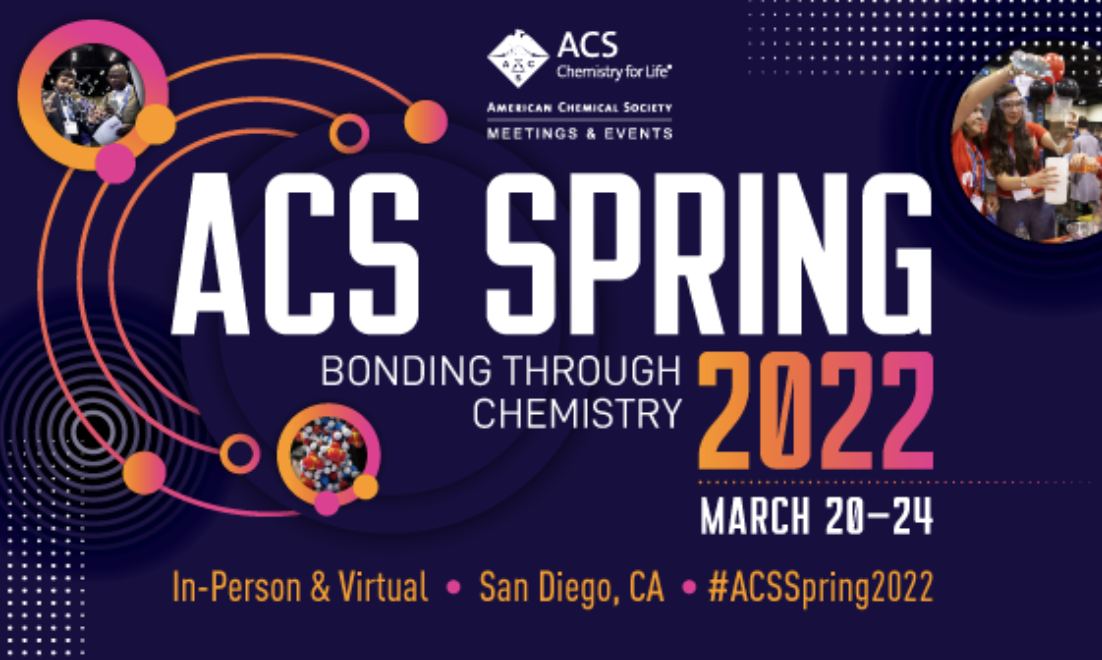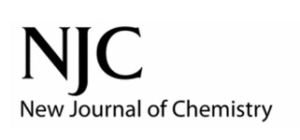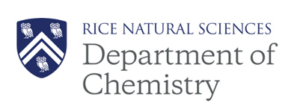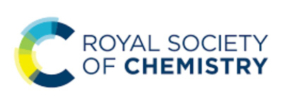
ACS Spring 2022 Bonding Through Chemistry
March 20, 2022 - March 24, 2022
ACS 2022 PHYS AWARDS SYMPOSIUM
Thank you to our sponsors:
POLARITON CHEMISTRY: MOLECULES IN OPTICAL CAVITIES
Strong coupling of spatially confined photons to the electronic and vibrational transitions of molecules causes the formation of cavity polaritons whose properties differ from those of each constituent. While researchers have elucidated some of the physical properties of cavity polaritons formed from molecules, the changes induced in chemical processes by cavity polariton formation remain unclear and have begun attracting significant research interest in the physical chemistry community. This symposium addresses the possibility that the parameters of cavity polariton formation can provide a novel means to control chemistry.
Aaron Rury, Wayne State University, aaron.rury@wayne.edu
Joel Yuen-Zhou, University of California, San Diego, joelyuen@ucsd.edu
Wei Xiong, University of California, San Diego, w2xiong@ucsd.edu
THE SYNERGY OF THEORY AND EXPERIMENT: A SYMPOSIUM IN HONOR OF PROF. JOHN F. STANTON
John F. Stanton, the William R. Kenan, Jr., Professor of Chemistry at the University of Florida’s Quantum Theory Project, is a role model for physical chemists: an insightful theorist who has developed some of the most important quantum chemical models, and who also works in close collaboration with an array of experimentalists pursuing some of the most challenging problems in molecular spectroscopy. In the spirit and recognition of Prof. Stanton’s work, this symposium will bring together theorists and experimentalists pursuing the state of the art of molecular quantum mechanics.
T. Daniel Crawford, Virginia Tech, crawdad@vt.edu
Anna Krylov, University of Southern California, krylov@usc.edu
Jürgen Gauss, Johannes Gutenberg-Universit t Mainz, gauss@uni-mainz.de
OPPORTUNITIES AND CHALLENGES IN ULTRAFAST X-RAY SCIENCE IN CHEMISTRY: THEORY AND EXPERIMENT
Ultrafast X-ray pulses have been increasingly utilized in recent years for interrogating electronic and nuclear structural dynamics in chemical systems, ranging from molecules to nanoscale materials and biological systems. These new advances in experimental methods enable us to gain new insight into fundamental chemical events. Extracting structural dynamics from experimental results also demands advances in the theory and computation of X-ray signals. This symposium aims for a timely discussion on advanced developments and applications in the research field of experimental and theoretical X-ray spectroscopy and scattering.
Xiaosong Li, University of Washington, xsli@uw.edu
Niri Govind, Pacific Northwest National Lab, niri.govind@pnnl.gov
Lin X. Chen, Northwestern Univ. & Argonne National Lab, l-chen@northwestern.edu
Amy Cordones-Hahn, Stanford University, acordon@slac.stanford.edu
Munira Khalil, University of Washington, mkhalil@uw.edu
MULTISCALE CHEMISTRY AND DYNAMICS AT SURFACES AND INTERFACES
The chemistry of surfaces and interfaces underpins critical processes in diverse fields of chemistry, ranging from heterogenous catalysis and electrochemistry to soft materials and biological processes. There has been considerable development of new microscopy, spectroscopy, surface science, and theoretical tools in recent years. The same techniques can probe crowded interfaces, unite molecular forces and chemical reactivity, and investigate dynamical surfaces that evolve as they catalyze chemical transformations. Because many of these breakthroughs have occurred in disparate and often siloed focus areas, this symposium seeks to unite latest breakthroughs in the physical and chemical dynamics occurring at surfaces and interfaces across multiple length and time scales.
Sarah King, University of Chicago, sbking@uchicago.edu
Matthew Gebbie, University of Wisconsin – Madison, gebbie@wisc.edu
Patrick El-Khoury, Pacific Northwest National Lab, patrick.elkhoury@pnnl.gov
NEW QUANTUM SOLUTIONS FOR QUANTUM SYSTEMS AND DEVICES
The third quantum revolution has now arrived, and it is important to ensure the availability of computing paradigms for rigorous assessment of proposals for next generation molecular- and material- qubits and for rigor in the design of quantum algorithms which are already focusing on down-folding of high accuracy methods. Requirements include coupled-cluster reliability at computational costs associated with density-functional theory and also the ability to accurately predict all couplings between electronic-, spin-, spinorbit, vibrational- and isotopic- degrees of freedom. This symposium will discuss the full diversity of methods to better embrace the need for such quantum diversity, and to understand how to efficiently account for both on-determinantal and multi-configurational effects.
Mark R. Pederson, University of Texas at El Paso, mrpederson@utep.edu
Laura Gagliardi, University of Chicago, lgagliardi@uchicago.edu
MEDIATION OF BIOLOGICAL PROCESSES BY MEMBRANES IN SPACE, TIME, AND FORCE
Many clinically relevant biochemical processes, including most signal transduction, occur on membranes. The cellular membrane participates in these processes not only by providing a passive surface, but also by mediating the molecular organization in time, space, and force. However, the delicate nature of self-assembled lipid bilayer structures imposes substantial challenges as experimental platforms, complicating the understanding of biological processes at the molecular level. This symposium will highlight recent advances in experimental and theoretical techniques, particularly quantitative spectroscopic methods. Broad areas of interest include: spatiotemporal coordination of signaling events via macroscopic phase separation; membrane curvature; mechanical forces on membranes; chemical kinetics under physical modulation; protein-lipid interactions; metal ions and lipid interactions.
Jean Chung, Colorado State University, jkchung@colostate.edu
Young Kwang Lee, San Diego State University, youngkwang.lee@sdsu.edu
Nancy Levinger, Colorado State University, Nancy.Levinger@colostate.edu
ENERGY AND CHARGE TRANSFER AT NANOSCALE INTERFACES
Understanding the fundamental factors that guide energy and charge transfer at nanoscale interfaces is crucial to the optimization of next generation energy devices, catalysts, and sensors. To this aim, developing new experimental techniques that break the boundaries with which we can temporally and spatially resolve dynamics at nanoscale interfaces can reveal new insights into how to structurally design these interfaces to efficiently control the flow of energy and charge. In addition, new theoretical approaches are necessary to address the interactions over multiple time and length scales. The primary goal of this symposium is to bring together spectroscopists, microscopists, theorists, and other researchers working on problems wherein interfacial charge and energy transfer is critical.
Libai Huang, Purdue University, libai-huang@purdue.edu
Sean Roberts, University of Texas, Austin, roberts@cm.utexas.edu
Katherine Willets, Temple University, kwillets@temple.edu
NEW DEVELOPMENTS IN HYBRID QM/QM, QM/MM, AND FRAGMENTATION METHODS
Modern quantum mechanical (QM) methods can provide accurate predictions of chemical phenomena, in principle even more reliably than experimental measurements. However, the steep computational scaling and memory/storage requirements of QM methods prevent their direct application to large systems of interest in real-life investigations, including biological macromolecules and supramolecular assemblies, phenomena in liquid phase and complex solid environments. QM simulations of complex molecular architectures rely on a clever partitioning of the system structure, using hybrid (QM/QM or QM/classical), and fragmentation methods. This symposium will bring together national and international leaders in the development of hybrid and fragmentation methods to discuss the state-of-the-art capabilities of these approaches, their current limitations, and the future directions of the field.
Marco Caricato, University of Kansas, mcaricato@ku.edu
John Herbert, The Ohio State University, herbert.44@osu.edu
BIOPHYSICAL AND BIOCHEMICAL DYNAMICS AND DIFFUSION
This symposium will address the latest advances in application and development in molecular and Brownian dynamics, including simulations, new methods, and chemical physics.
Rommie Amaro, University of California, San Diego, ramaro@ucsd.edu
Michael Gilson, University of California, San Diego, mgilson@health.ucsd.edu
Giulia Palermo, University of California, Riverside, giulia.palermo@ucr.edu
PHYSICAL CHEMISTRY POSTER SESSION
Contributions from all areas of physical chemistry are highly encouraged for the poster session (likely to be held Wednesday, 23 March), from 6:00 to 8:00 PM. Up to six awards with monetary prizes will be given for exemplary work. To be eligible for the awards, the presenting author must be a graduate or undergraduate student at the time of the poster presentation and must be present during judging.




